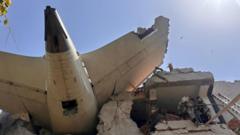The Air India Boeing 787-8 Dreamliner, which took off from Sardar Vallabhbhai Patel International Airport in Ahmedabad, crashed mere moments after departure on Thursday, tragically killing 241 people, including both passengers and crew. The aircraft reportedly veered off and struck a residential area, hitting structures including a hospital complex and a student hostel.
The single survivor of the harrowing incident, British national Vishwashkumar Ramesh, emerged from the wreckage with no idea how he managed to escape. He recounted the horror, describing a loud noise shortly after take-off, indicating the calamity that would unfold just seconds later. As rescue teams worked tirelessly at the crash site, officials acknowledged that the death toll could rise, classifying the crash as one of the worst in Indian aviation history.
Flight AI171 had 230 passengers on board, comprising primarily Indian nationals, Britons, and others from various countries. As of now, 204 bodies have been recovered, though officials remain uncertain about how many belonged to the plane versus those on the ground. The crash site remains chaotic, with debris scattered across a wide area, further complicating recovery efforts.
Eyewitness accounts describe catastrophic scenes, with smoke billowing from buildings and remnants of the crushed aircraft embedded in the wreckage. Tragically, many students were reported to be in the canteen of the medical facility when the disaster struck.
Tata Group, the parent company of Air India, has promised significant compensation to each victim’s family. Prime Minister Narendra Modi addressed the tragedy, expressing his sorrow, while condolences poured in from international leaders including Canadian and British officials, emphasizing the global reach of this disaster.
As investigations unfold, both US and UK authorities are sending teams to assist local investigations led by India’s Aircraft Accident Investigation Bureau. The cause of the crash remains under scrutiny, further alarming the aviation community.
The single survivor of the harrowing incident, British national Vishwashkumar Ramesh, emerged from the wreckage with no idea how he managed to escape. He recounted the horror, describing a loud noise shortly after take-off, indicating the calamity that would unfold just seconds later. As rescue teams worked tirelessly at the crash site, officials acknowledged that the death toll could rise, classifying the crash as one of the worst in Indian aviation history.
Flight AI171 had 230 passengers on board, comprising primarily Indian nationals, Britons, and others from various countries. As of now, 204 bodies have been recovered, though officials remain uncertain about how many belonged to the plane versus those on the ground. The crash site remains chaotic, with debris scattered across a wide area, further complicating recovery efforts.
Eyewitness accounts describe catastrophic scenes, with smoke billowing from buildings and remnants of the crushed aircraft embedded in the wreckage. Tragically, many students were reported to be in the canteen of the medical facility when the disaster struck.
Tata Group, the parent company of Air India, has promised significant compensation to each victim’s family. Prime Minister Narendra Modi addressed the tragedy, expressing his sorrow, while condolences poured in from international leaders including Canadian and British officials, emphasizing the global reach of this disaster.
As investigations unfold, both US and UK authorities are sending teams to assist local investigations led by India’s Aircraft Accident Investigation Bureau. The cause of the crash remains under scrutiny, further alarming the aviation community.






















